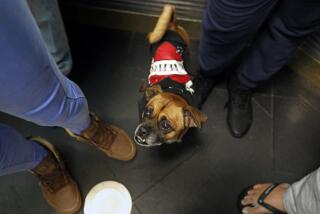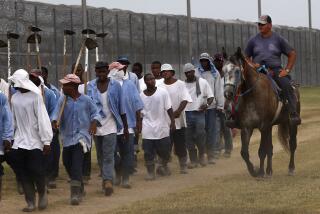Killing Them Softly
LITTLE ROCK, Ark. — Chained upside down by their hooves, blood spurting from the jugular, the hogs were supposed to be dead, or at least unconscious, as the conveyor belt rolled them along to be gutted.
Now and then, though, one would rear back and strain to right itself.
No one made much fuss. The animals would be sliced for sausage within minutes. If a few left the kill floor still aware, still kicking -- well, that was how slaughterhouses operated.
Then Jim Stonehocker heard a speech that changed the way his hogs die. A competitor in the meat business was talking about stewardship -- about how to make good sausage, and good profits, while treating animals with dignity, so they die without terror and as much as possible, without pain.
“I’m always going to have meat at the center of my plate. I’m always going to wear a leather belt. But we can treat these animals with more respect,” said Stonehocker, who runs the sausage company Odom’s Tennessee Pride. “In my mind, ‘humane slaughter’ was an oxymoron. I’ve had my awakening.”
So have many of his colleagues across the food industry.
A revolution in livestock handling in recent years has improved the lives and the deaths of millions of animals -- most dramatically on the kill floors that handle cows and pigs, but also in farmyards, hen houses and even transport trucks.
The reforms are voluntary. Yet they have gained the momentum to become standard in much of the food industry. Many restaurants will not buy burger patties from a slaughterhouse that sends its cows to the kill floor bellowing in fear. Many supermarkets will not buy eggs from a farmer who cuts off hens’ beaks to stop them from pecking one another.
“Customers used to tell us what they wanted to eat. Now they tell us how they want it produced,” said Ken Klippen, a vice president of United Egg Producers, a trade group based in Alpharetta, Ga.
Animal-welfare activists caution that many cows, pigs and especially chickens still suffer mightily, trapped in a system that treats animals as commodities to be pushed through an assembly line from birth to death and onto the dinner plate as cheaply as possible. They decry such practices as docking pigs’ tails, burning the horns off male cattle and cramming hens into bare wire cages as barbaric and unnecessary. Still, they sense the tide is turning.
For the first time since industrialized farming took hold, they say, animals are being viewed as living creatures with wants and needs and fears.
One sign of how attitudes have shifted: Hundreds of farmers, truck drivers and slaughterhouse managers recently attended workshops on such topics as “Inside the Mind of a Steer,” “Humane Turkey Production” and “Creating an Animal Welfare Mind-Set in Your Company,” in a seminar sponsored by the American Meat Institute.
Another indication: The U.S. Department of Agriculture plans to hire 50 new inspectors this year to monitor animal welfare in slaughterhouses. Politicians too are taking up the issue. In California, the Assembly Agricultural Committee will vote this week on a bill that would outlaw the common practice of confining pregnant sows and veal calves in crates so cramped that they cannot turn around. A similar bill is pending in New Jersey. Last fall, voters in Florida approved a ballot measure outlawing sow gestation crates, which farmers use to shield pigs from the stress of competing with other animals for food and space.
“There’s been a real change in consciousness,” said Bruce Friedrich, a leading organizer with People for the Ethical Treatment of Animals.
“A phenomenal change,” agreed Joy Mench, director of the Center for Animal Welfare at UC Davis.
In part, the reforms are driven by self-interest. When an animal is bruised, its flesh turns mushy and must be discarded. Even stress, especially right before slaughter, can affect the quality of meat.
As Jim Reeves, a cattle breeder in Texas, put it: “A happy animal is going to make a better eating experience for the public.”
So from farm to kill floor, livestock handlers are increasingly focused on keeping their charges happy. Premium Standard Farms, a major pork producer based in Kansas City, Mo., has even begun training its workers to greet each pig with a gentle pat rather than shoving them out of the way in the rush to complete daily chores.
“The conditions still may not be ideal. But [the new attitude toward livestock] will improve the lives of many, many animals,” said Adele Douglass, a farm expert at the American Humane Assn.
The changing approach to animal welfare has its roots in a 1996 federal study. The USDA hired Temple Grandin, an animal scientist at Colorado State University, to inspect two dozen meat-processing plants across the nation. She announced her visits in advance. Still, she found suffering that appalled her.
By federal law, animals are supposed to be knocked unconscious so they feel no pain before slaughter. With cows and pigs, that’s often accomplished by shooting a retractable bolt into their brains.
At two-thirds of the beef plants she inspected, Grandin noted that the bolt guns were not working or not being used properly. Many cows suffered repeated shots to the brain -- or remained conscious as they moved down the line to be dismembered. Grandin found similar failings in one-third of the pork plants.
Even before they got to the kill floor, animals were in pain, stumbling on slippery floors and piling on one another in fear. One plant had to prod 80% of its hogs with a mild shock to get them walking.
Grandin realized that it was not enough to tell workers to treat animals humanely. They would need quantifiable performance standards: Don’t prod more than 25% of pigs. Don’t let more than 1% of cattle slip. She set those benchmarks, based on the highest standards a handler could be expected to meet day in and day out. Then she trained workers to measure up.
Grandin, who is autistic, says she perceives the world as a series of images, much as a farm animal would. Crawling through chutes on her knees, she has an uncanny ability to pick out the mundane sights and sounds that can stress an animal into hysteria -- the glint of a metal chain, the hiss of an air vent, the motion of a worker’s hard hat bobbing in and out of view.
To their amazement, producers found that removing those distractions calmed the livestock. The animals no longer balked, so their handlers didn’t need to swat them on the rump or zap them with an electric prod to get them moving. Grandin also urged the installation of non-slip flooring so livestock wouldn’t trip.
After meat producers carried out her suggestions, Grandin used audits to show them how much they improved.
Her objective, numbers-based analysis caught fire in an industry long wary of even discussing animal welfare.
“We were always concerned that there could be a lot of subjectivity about what is humane,” said Janet Riley, senior vice president of the American Meat Institute. “But when she said, ‘Make sure that less than X percent of animals slip and fall,’ that was real clear. It was a turning point.”
McDonald’s hired Grandin in 1997 to work with its suppliers. Two years later, the fast-food giant began surprise inspections of its slaughterhouse suppliers -- and cut ties with those that flunked.
About that time, PETA launched an intense campaign against McDonald’s. Protesters outside Golden Arches around the world handed out “Unhappy Meals” with figurines of bloody, butchered animals. McDonald’s insists that PETA’s antics were “not a factor.” But in the fall of 2000, the chain announced standards for humane treatment of every animal that produced its nuggets, burgers, eggs and bacon.
PETA followed up with protests against Burger King, Wendy’s and Safeway markets. One after another, the corporations set tough standards for animal welfare -- and demanded their suppliers comply.
Grandin was able to measure the results through nationwide audits she conducts for her private consulting business. In 1996, just 36% of the beef plants she inspected effectively knocked their cattle insensible before slaughter. Last year, 94% got it right. And the changes go beyond the kill floor.
At the sausage plant here, for instance, Paul Whitfield now waves a blue flag and clucks “yee-ahhh, yee, yee!” to get the pigs walking. He no longer uses an electric prod. “We sure don’t have to be as aggressive as before,” he said. “It’s a lot less stressful, on us and on them.”
Truck drivers too are adopting gentler techniques; across the nation, thousands have taken workshops to certify as humane handlers. They learn how far a pig’s peripheral vision extends, so they know where to stand when they’re trying to get an animal moving. They are taught to avoid slamming the brakes, because the jolt can knock cattle down. Some livestock haulers have even started to provide climate control, misting animals with a cooling spray in hot weather.
Animal-rights activists applaud such changes. PETA’s Friedrich goes as far as to pronounce, with pride, that “we’ve achieved societal sea change” in the treatment of livestock.
Then he rushes to add: “The level of abuse is still such that it would horrify any compassionate person.”
The egg industry, for instance, lets producers put an “animal care certified” logo on packages if they give their hens more cage space, moving from the standard 48 square inches per bird to 67. Industry backers say that’s all the space a hen needs. But activists point out that 67 square inches is smaller than a piece of paper.
“Those hens can never flap their wings, never touch earth, never see sunlight,” said Paul Shapiro, who runs an animal-rights group called Compassion Over Killing. “For the industry to treat this as the end of the debate is irresponsible.”
PETA is especially concerned about poultry packing plants, which have received less scrutiny than beef and pork processors though more than 90% of animals killed for food in this country are chickens.
The standard method for slaughtering chickens -- at a rate of 11,000 birds an hour -- involves shackling them upside down from a conveyor belt that runs along the ceiling. Their heads are dunked in a shallow “stun bath” to anesthetize them. A revolving blade then slices their necks.
Chicken processors defend their methods as humane, arguing that it’s a lot less traumatic than the old-fashioned farm-boy method of wringing the bird’s neck.
But activists contend that many chickens are not properly stunned or sliced, and end up boiling to death in the scalding tank meant to loosen their feathers. “I’ve stood there on the kill floor and seen how they look at you. They try everything in their power to get away. They may not be able to read and write, but they know what’s going on,” said Virgil Butler, a former employee of a chicken plant in Arkansas who is working with PETA on a “Kentucky Fried Cruelty” campaign, featuring a demonic Colonel Sanders dripping blood.
KFC rejects all allegations of cruelty. The fast-food chain says it sends inspectors on unannounced tours of its suppliers to be sure the birds are “slaughtered quickly and without pain.”
KFC does not send inspectors to poultry farms.
In general, farms, ranches and feedlots have been slower than slaughterhouses to adopt humane-handling practices. The delay can be attributed in part to scale: It’s much easier to implement reform in 800 meat-packing plants than on 900,000 cattle ranches. “We have ranches in every state, in every climate, with [dozens] of different breeds. It’s a real challenge to put together guidelines that are appropriate for all that diversity,” said Gary Weber, executive director of the National Cattlemen’s Beef Assn.
There have been a few notable reforms. McDonald’s, Burger King and other chains have forced their egg suppliers to end the practice of starving the hens for several days each year to boost egg production. The restaurants are trying to prod pork producers to stop confining pregnant sows in cramped “gestation crates” to eliminate the stress of competing for food. They’re pushing for an end to the tradition of branding cattle with hot irons.
But the powerful groups that represent farmers and ranchers have deflected some of the pressure by insisting that any reform be based on science, not sentiment.
They argue there’s no scientific proof that chickens need sunlight or that pregnant sows need space to move. They complain that activists are inappropriately treating livestock like pets when they call for poultry to be given toys to ease the boredom of confinement, or calves to be given painkillers before castration.
And they point out that many reforms have unintended consequences. Activists call for an end to the practice of cutting off pigs’ tails. Farmers respond that the animals will then suffer painful bites on the tail from other pigs. Activists demand a layer of dirt in stalls so pigs can root. Farmers respond that dirt can harbor dangerous parasites, while a concrete floor does not.
“We fully recognize that we have an ethical obligation to the animals we raise and slaughter, but we have to be wary of rushing to judgment about what is or not humane,” said Charlie Arnot, a vice president for pork producer Premium Standard Farms. “Striking a balance between what can be supported by science and what the activists want will be a real challenge.”
Back at the slaughterhouse in Little Rock, plant manager Jim McConnell says he may have found that balance.
Just a few years ago, he said, he thought nothing of letting hogs sit for hours in the trailers that transported them, stifling in summer, freezing in winter. Those that arrived too lame to walk were dragged across the yard. Those that balked at the steep ramp to the holding pens were shocked with prods.
And yes, some pigs “came back to life” after they were supposed to be insensible. A few even staggered off the conveyor belt and charged at the kill floor workers.
“We thought abuse was someone beating an animal,” McConnell said. “We didn’t realize. We didn’t know.”
Odom’s Tennessee Pride does things differently now. Hogs are unloaded as soon as they arrive, into cool pens with long troughs of water. If they can’t walk, they are euthanized on the spot. “There has been a cultural change here,” said production manager Leonardo Ruiz.
On the kill floor, workers no longer shoot the hogs in the brain with retractable bolts. Instead, they clap a harness over the animal’s head and back and deliver an electric charge. A computerized display lets them know if they’re getting a “good stun” or if they need to reposition the harness.
Some hogs squeal when the stun is applied. Others jerk. All go rigid in seconds as the electrical impulse induces cardiac arrest. When the harness is lifted, the animals slump, flaccid and unblinking, and roll down onto a conveyor belt. A second worker checks for signs of consciousness and then quickly slits the throat.
Everyone on the kill floor knows they could be fired if they let a hog suffer.
“They’re good animals,” worker Lionel Allen said. “We try to treat them right.”
More to Read
Sign up for Essential California
The most important California stories and recommendations in your inbox every morning.
You may occasionally receive promotional content from the Los Angeles Times.










